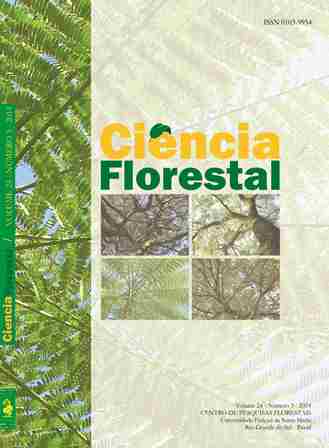DIAMETER AND BASAL AREA RATIO RELATIONSHIP WITH SELF-THINNING IN <i>Pinus taeda</i> L. EVEN-AGED STANDS
DOI:
https://doi.org/10.5902/1980509814584Keywords:
diameter, basal area, self-thinning, densityAbstract
http://dx.doi.org/10.5902/1980509814584
This work aimed to study the relationship of the ratio of mean diameter and basal area at the self-thinning moment; the diameter tree growth; the occurrence and moment of self-thinning using the diameter-area proportion and the rate of self-thinning, comparing it to the law of the -3/2 power in stands of Pinus taeda L.. The data was collected from permanent plots experiment installed into a Pinus taeda L. stand and measured annually until 18 years-old with different spacing managed with complete density. The Tang model was used in order to relate the density of trees with the mean diameter. The self-thinning model showed precision and high efficiency. However, it showed a different slope coefficient of -1.65 that stressed from the self-thinning law of -3/2. At the self-thinning moment, the trees reached a diameter of 14 and 17 cm at the space of 2 x 2 and 3 x 3 with basal area of 38.8 and 47.5 m2/ha, respectively. In all spacing the maximum basal area was 78 m2/ha at 18 years old showing upward trend. In that spacing the diameter and basal area ratio at the moment of occurrence of self-thinning was 0.36 and 0.37, respectively.
Downloads
References
CELLINI, J. M. et al. Modelos de perfil de tronco en Nothofagus pumilio (Polp, et Endl,) Krasser y su utilización en el cálculo del volumen total. Invest. Agr,: Sist. Recur. For. Ministerio de Agricultura, Instituto Forestal de Investigaciones y Experiencias, Madrid, n. 2, v.11, p. 245-261, 2002.
CURTIS, R. O. A simple index of stand density for Douglas-fir. Forest Science, Bethesda, n. 1, v. 28, p. 92-94, March, 1982.
DEL RIO, M.; MONTERO, G.; BRAVO, F. Analysis of diameter-density relationships and self-thinning in non-thinned even-aged Scots pine stands. Forest Ecology and Management. Amsterdan, v.142, p.79-87, March, 2001.
EMBRAPA. Sistema brasileiro de classificação de solos. Brasília: Embrapa, 1999, 412 p.
MOTTA, F. S.; BEIRSDORF, M. J. C.; GARCEZ, R. B. Zoneamento agrícola do Rio Grande do Sul e Santa Catarina: normas agro-climáticas. Pelotas: Ministério da Agricultura. 1971. 80 p.
OSAWA, A.; ALLEN, R. B. Allometric theory explains self-thinning relationships of mountain beech and Red pine. Ecology. n. 74, v. 4, p. 1020-1032, Apr. 1993.
PALAHI, M.; MIIMA, J.; MONTERO, E. Stand-level yield model for scots pine (Pinus sylvestris) in north-east Spain. Invest. Agr. Sist. Recr. For. Ministerio de Agricultura, Instituto Forestal de Investigaciones y Experiencias, Madrid, v. 11, n. 2, p. 409-424, 2002.
REID, R. Diameter-basal area ratio as a practical stand density measure for pruned plantations. Forest Ecology and Management. Amsterdan, v. 233, p. 375-382, Sept. 2006.
REINEKE, L. H. Perfecting a stand-density index for even-aged forests. Canadian Agricultural Research. Ottawa, n. 46, p. 627-638, 1933.
SANTA CATARINA. Gabinete de Planejamento e Coordenação Geral. Subchefia de Estatística. Geografia e Informática. Atlas de Santa Catarina. Rio de Janeiro: Aerofoto Cruzeiro. 1986. 173 p.
SAS Institute Inc. SAS/STAT user’s guide. Version 8 (computer manual). SAS Institute Inc., Cary. N.C. 1999.
SCHNEIDER, P. S. P. Autodesbaste e diagrama de manejo da densidade em povoamento de Pinus taeda L. 2008. 94 f. Dissertação (Mestrado em Engenharia Florestal) - Universidade Federal de Santa, Santa Maria, 2008.
SMITH, N. J.; HANN, D. W. A growth model based on the self-thinning rule. Canadian Journal of Forest Research. New Westminster, v. 16, n. 2, p. 330-334, Apr. 1986.
STERBA, H.; MONSERUD, R. A. The maximum density concept applied to uneven-aged mixed-species stands. Forest Science. Bethesda, v. 39, n. 3, p. 432-452, Aug. 1993.
TANG, S. et al, A growth and self-thinning model for pure even-aged stands: theory and applications. Forest Ecology and Management. Amsterdan, v. 70, p. 67-73, Dec. 1994.
TANG, S.; MENG, F. R.; MENG, C. H. The impact of initial stand density and site index on maximum stand density index and self-thinning index in a stand self-thinning model. Forest Ecology and Management. Amsterdan, v. 75, p. 61-68, June, 1995.
WEST, P. W.; BOUROUGH, C. J. Tree supervision and the self-thinning, Rule in a monoculture of Pinus radiata D, Don. Annals of Botany. Oxford, v. 52, p. 149-158, 1983.
WESTOBY, M. The place of the self-thinning rule in population dynamics. American Naturalist. v. 118, n. 4, p. 581-587, Oct. 1981.
YODA, K.; KIRA, T.; OGAWA, H.; HOZUMI, K. Self-thinning in over crowed pure stands under cultivated and natural conditions. Jor. Biol. Osaka City Univ. Osaka, v. 14, p. 107-129, 1963.
ZEIDE, B. A relationship between size of trees and their number. Forest Ecology and Management. Amsterdan, v. 72, p. 265-272, Apr. 1995.
ZEIDE, B. Analysis of the 3/2 power law of self-thinning. Forest Science. Bethesda, v. 33, n. 2, p. 17-537, June, 1987.
ZEIDE, B. Self-thinning and stand density. Forest Science. Bethesda, v. 37, n. 2, p. 517-523, June, 1991.
ZEIDE, B. Tolerance and self-tolerance of trees. Forest Ecology and Management. Amsterdan, v. 13, p. 149-166, Nov. 1985.







